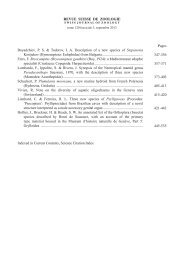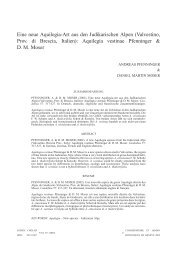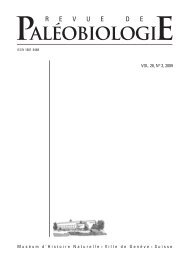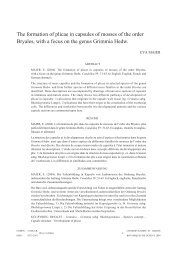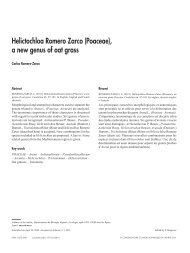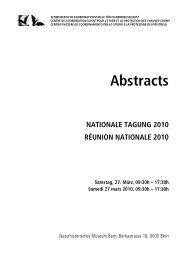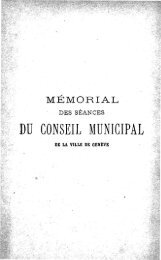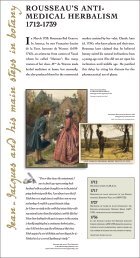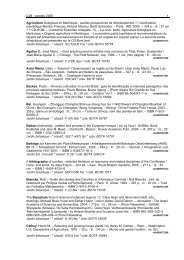Full text article - Ville de Genève
Full text article - Ville de Genève
Full text article - Ville de Genève
You also want an ePaper? Increase the reach of your titles
YUMPU automatically turns print PDFs into web optimized ePapers that Google loves.
Two new epitypes in Danaea (Marattiaceae, Pteridophyta)<br />
selected from original historical collections in Paris<br />
Maarten J. M. Christenhusz<br />
Abstract<br />
CHRISTENHUSZ, M. J. M. (2007). Two new epitypes in Danaea (Marattiaceae,<br />
Pteridophyta), selected from original historical collections in Paris. Candollea<br />
62: 221-230 In English, English and French abstracts.<br />
Charles Plumier (1646-1704) completed nearly 200 drawings<br />
of ferns and clubmosses during his travels in the French Caribbean<br />
between 1689 and 1695. Many of these plates have been<br />
cited by Linnaeus in his Species Plantarum (1753), and were<br />
subsequently <strong>de</strong>signated as lectotypes for the taxa they represent.<br />
Surveys of historical specimens from the herbarium in the<br />
National Museum of Natural History in Paris have revealed<br />
many original fern specimens annotated by Plumier that have<br />
most probably been collected by Surian. Several of these specimens<br />
should be <strong>de</strong>signated as epitypes, in addition to the lectotypified<br />
Plumier illustrations, because not all distinguishing<br />
characters necessary to unambiguously i<strong>de</strong>ntify the species are<br />
represented in the Plumier plates. The advantage of these epitypes<br />
is that they are specimens, rather than illustrations, and<br />
show characters that are not visible in Plumier’s illustrations.<br />
We have chosen the genus Danaea Sm. (Marattiaceae) as an<br />
example and provi<strong>de</strong> new synonymy and a complete taxonomic<br />
history of the genus. Two new epitypes of Danaea are proposed<br />
here, Danaea alata Sm. and Danaea nodosa (L.) Sm. The name<br />
Danaea angustifolia C. Presl is lectotypified.<br />
Key-words<br />
MARATTIACEAE − Danaea − Antilles − Plumier − Epitypes −<br />
Ferns − Historical specimens − Pre-Linnaean illustrations<br />
ISSN: 0373-2967 Candollea 62(2): 221-230 (2007)<br />
Résumé<br />
Address of the author: MJMC: Department of Biology, University of Turku, 20014 Turku, Finland.<br />
Email: maarten.christenhusz@utu.fi<br />
Submitted on December 19, 2006. Accepted on October 30, 2007.<br />
CHRISTENHUSZ, M. J. M. (2007). Deux nouveaux épitypes <strong>de</strong> Danaea (Marattiaceae,<br />
Pteridophyta), sélectionnés à partir <strong>de</strong>s collections originales historiques<br />
à Paris. Candollea 62: 221-230. En anglais, résumés anglais et français.<br />
Charles Plumier (1646-1704) a réalisé près <strong>de</strong> 200 illustrations<br />
<strong>de</strong> fougères et <strong>de</strong> lycopo<strong>de</strong>s durant son voyage dans les Caraïbes<br />
françaises entre 1689 et 1695. Ces planches ont été citées, entre<br />
autres, par Linné dans son Species Plantarum (1753), et ont été<br />
désignées comme les lectotypes <strong>de</strong>s taxons qu'elles représentent.<br />
Des recherches récentes dans les collections historiques <strong>de</strong> l'herbier<br />
du Muséum national d'Histoire naturelle à Paris ont permis<br />
<strong>de</strong> découvrir <strong>de</strong> nombreux spécimens annotés par Plumier et<br />
probablement collectés par Surian. Plusieurs <strong>de</strong> ces spécimens<br />
<strong>de</strong>vraient être désignés comme épitypes, en complément <strong>de</strong>s<br />
illustrations <strong>de</strong> Plumier classées comme lectotypes, du fait <strong>de</strong><br />
l'absence dans les planches <strong>de</strong> Plumier <strong>de</strong> certains caractères<br />
distinctifs nécessaires à une i<strong>de</strong>ntification sans ambiguïté <strong>de</strong>s<br />
espèces. Ces épitypes présentent l’avantage d’avoir conservé<br />
<strong>de</strong>s caractères qui ne sont pas visibles sur les illustrations. Nous<br />
avons choisi le genre Danaea Sm. (Marattiaceae) comme<br />
exemple et en donnons une nouvelle synonymie ainsi qu'un historique<br />
taxinomique. Deux nouveaux épitypes <strong>de</strong> Danaea sont<br />
proposés ici, Danaea alata Sm. et Danaea nodosa (L.) Sm. Le<br />
nom Danaea angustifolia C. Presl est lectotypifié.<br />
© CONSERVATOIRE ET JARDIN BOTANIQUES DE GENÈVE 2007
222 – Candollea 62, 2007<br />
Introduction<br />
The French missionary Charles Plumier (1646-1704), a<br />
member of the catholic or<strong>de</strong>r of the Minims, sketched numerous<br />
plants during his stay on Martinique and Hispaniola. He<br />
travelled in the Caribbean between 1689 and 1695, and had a<br />
close working relationship with Joseph Donat Surian, who later<br />
returned to France with a large collection of dried specimens<br />
(many of which are still preserved in P). Plumier did not collect<br />
specimens himself, but instead drew and <strong>de</strong>scribed the plants he<br />
studied in the field, which were subsequently collected by<br />
Surian. These drawings and <strong>de</strong>scriptions formed the basis of a<br />
series of works: PLUMIER (1693, 1703, 1705), <strong>de</strong>scribing the<br />
flora of the French Caribbean. In PLUMIER (1705), 50 plates of<br />
his 1693 publication were reproduced. In total nearly two hundred<br />
ferns and clubmosses were <strong>de</strong>scribed and illustrated by<br />
Plumier (PENNELL, 1945).<br />
LINNAEUS (1753) based several species <strong>de</strong>scriptions on<br />
Plumier’s illustrations, since he had been able to study copies<br />
of these in Groningen, the Netherlands. Several authors such<br />
as FÉE (1866), JENMAN (1888), URBAN (1925: 273-397), PROC-<br />
TOR (1977, 1985, 1989), LELLINGER & PROCTOR (1983) and<br />
PROCTOR & LOURTEIG (1990) <strong>de</strong>signated Plumier plates as<br />
lectotypes for many Linnaean fern species. Also in several<br />
West Indian fern floras, PROCTOR (1977, 1985, 1989) selected<br />
lectotypes from among Plumier's drawings.<br />
Despite the good quality and <strong>de</strong>tail of the Plumier plates,<br />
a plate as a lectotype can be problematic if the image does not<br />
<strong>de</strong>pict all characters necessary to distinguish between species.<br />
Some characters such as hairs, scales, glands or venation may<br />
not be well illustrated. According to MCNEILL & al. (2006),<br />
“when a holotype, a lectotype, or a neotype is an illustration,<br />
the specimen or specimens upon which that illustration is<br />
based should be used to help <strong>de</strong>termine the application of the<br />
name” (recommendation 8A.1). For several species the Plumier<br />
plates are <strong>de</strong>monstrably ambiguous, which would imply<br />
the <strong>de</strong>signation of the original specimens in the Surian and<br />
Tournefort collections that were annotated by Plumier, as epitypes<br />
(MCNEILL & al., 2006, <strong>article</strong> 9.7). The lectotype and<br />
epitype should both be consi<strong>de</strong>red when <strong>de</strong>ciding on the i<strong>de</strong>ntity<br />
of a species. It is in this spirit that I have conducted the<br />
study of the specimens in the Tournefort collection and other<br />
historical collections at P.<br />
Many of the original specimens on which Plumier based his<br />
illustrations are preserved in the herbaria of Tournefort (P-TRF),<br />
Vaillant (P), and Surian (P). In cases where the illustration is<br />
not sufficient for the unambiguous i<strong>de</strong>ntification of the plant,<br />
many of these specimens may be <strong>de</strong>signated as epitypes.<br />
Because I am currently revising the genus Danaea Sm.<br />
(Marattiaceae, Pteridophyta), I chose this genus as an example<br />
for epitypifying specimens linked to Plumier plates. The<br />
i<strong>de</strong>ntity of the two species <strong>de</strong>picted by Plumier is ambiguous,<br />
because the venation, pinna margins and petiole no<strong>de</strong>s are not<br />
clearly illustrated, and these names have therefore often been<br />
misapplied (i.e. PRESL, 1845; JENMAN, 1898; ROLLERI, 2004).<br />
The illustrations are thus not sufficient to distinguish these species<br />
they <strong>de</strong>pict from related taxa. The epitypes selected in this<br />
study will clarify this issue and may prevent confusion of<br />
D. alata Sm. and D. nodosa (L.) Sm. with related species in<br />
the future.<br />
Taxonomic History of Danaea<br />
The first mention of taxa now belonging to the genus<br />
Danaea was by PLUMIER (1705), who published two plates<br />
that he named: “Lingua cervina nodosa minor” (Fig. 1) and<br />
“Lingua cervina nodosa maior” (Fig. 2). LINNAEUS (1753)<br />
applied “Lingua cervina nodosa major” to Acrostichum nodosum<br />
L. Even though PLUMIER (1705) stated that the species<br />
was observed in either Martinique or Hispaniola, LINNAEUS<br />
(1753) wrote “Habitat in Dominica”, and further indicated<br />
“stipitis articulis nodosis”, an unfortunate error because this<br />
species does not bear no<strong>de</strong>s on the petioles. LINNAEUS (1763)<br />
reconsi<strong>de</strong>red the placement of Acrostichum nodosum and<br />
transferred it to Asplenium.<br />
The second plate of PLUMIER (1705: 91, tab. 109) “Lingua<br />
cervina nodosa minor”, was not mentioned by LINNAEUS<br />
(1753), but SMITH (1793) <strong>de</strong>scribed it as Danaea alata, indicating<br />
“Habitat in Martinica, Plumier in herb. Linn.” as the<br />
original material (not present at LINN). In this <strong>article</strong> SMITH<br />
(1793) <strong>de</strong>scribed Danaea in honor of “Bot. Prof. J. Petri<br />
Mariae Dana”, and he based his new genus on Asplenium<br />
nodosum (L.) L. ( Acrostichum nodosum L.), citing “Plumier,<br />
Fil. 90, 1. 108” and referring to “a specimen in the Linnaean<br />
Herbarium”. The latter was probably an assumption<br />
ma<strong>de</strong> at the time, for there is no original Danaea material<br />
known in LINN.<br />
RUDGE (1805: 24) ad<strong>de</strong>d a third species, D. simplicifolia<br />
Rudge, which is remarkable for its undivi<strong>de</strong>d bla<strong>de</strong>s. SMITH<br />
(1808) revised his genus for Rees’ Cyclopaedia, and ad<strong>de</strong>d a<br />
fourth species D. elliptica Sm. The <strong>de</strong>scription of this species<br />
was ambiguous, and therefore this name became very wi<strong>de</strong>ly<br />
but variously applied. However, the material (Herb. Sloane 1:<br />
85, BM-SL) indicated in the original <strong>de</strong>scription by SMITH<br />
(1808) and lectotypified by PROCTOR (1977), is a juvenile of<br />
D. nodosa, and thus the name D. elliptica becomes a synonym<br />
of that species (CHRISTENHUSZ & TUOMISTO, 2006).<br />
In subsequent years, six new species were ad<strong>de</strong>d to the genus<br />
(DESVAUX, 1811; RADDI, 1825: 75-76; KUNZE, 1837, 1840: 55-<br />
57, 1843: 137-138), until PRESL (1845) revised the genus. He<br />
<strong>de</strong>scribed four additional species, erroneously synonymised<br />
D. geniculata Raddi un<strong>de</strong>r D. elliptica, and placed the 11 species
known to him into three sections: Eudanaea C. Presl, Arthrodanaea<br />
C. Presl and Holodanaea C. Presl, based on inconsistent<br />
morphological characters. Additionally two species<br />
were placed into segregate genera: Heterodanaea C. Presl<br />
and Danaeopsis C. Presl. The lectotype of Heterodanaea<br />
[Danaea stenophylla Kunze; Gua<strong>de</strong>loupe, l’Herminier 213<br />
ex herb. Bory, Danaea nr. 37 (K!), <strong>de</strong>signated by PROCTOR<br />
(1977)] is a specimen i<strong>de</strong>ntical to Danaea alata (ROLLERI,<br />
2004). It therefore becomes a synonym of that species, and<br />
Heterodanaea is thus a synonym of Danaea. The other genus<br />
Danaeopsis was based on Danaea paleacea Raddi of which<br />
the holotype is: Raddi s.n. (PI!) from Serra d’Estrella, Est.<br />
Sao Paulo, Brazil. This specimen has reticulate venation, a<br />
character that does not occur in Danaea, and is Bolbitis<br />
serratifolia (Kaulf.) Schott (PICHI-SERMOLLI & BIZZARRI,<br />
2005), which coinci<strong>de</strong>ntally is the type species of the genus<br />
Bolbitis Schott (Dryopteridaceae). To confuse matters, the<br />
fossil genus Danaeopsis Heer (HEER, 1865) is in use for certain<br />
marattialean fossils. The correct name for these fossils<br />
is Marantoi<strong>de</strong>a Jaeger (WEBB, 2001). Presl's genera, sections<br />
and classification were not wi<strong>de</strong>ly accepted and were rarely<br />
followed by subsequent authors on Danaea.<br />
Over the following 57 years, little taxonomic attention was<br />
given to Danaea apart from listings in various indices (i.e.<br />
MOORE, 1861: 285-288), and the occasional addition of new<br />
species (LIEBMANN, 1849; FÉE, 1869; REICHENBACH, 1872;<br />
BAKER, 1881, 1891; JENMAN, 1898).<br />
UNDERWOOD (1902) published the first review of the genus.<br />
He <strong>de</strong>scribed, typified, and re<strong>de</strong>fined several species and provi<strong>de</strong>d<br />
an analytical key for 12 species, of which five were new<br />
to science. This work was adapted for the North American<br />
Flora, where UNDERWOOD (1909) <strong>de</strong>termined the type locality<br />
for D. nodosa as “Near Port <strong>de</strong> Paix, Haiti”, and where he<br />
provi<strong>de</strong>d <strong>de</strong>scriptions of a dozen species, which, remarkably,<br />
were a different set of species than he presented in his 1902<br />
review. Meanwhile several new species were <strong>de</strong>scribed<br />
(CHRIST, 1905, 1907, 1909, 1910; ROSENSTOCK, 1907, 1909),<br />
and CHRISTENSEN (1906, 1913) provi<strong>de</strong>d an overview of the<br />
genus listing a total of 32 species names.<br />
SMITH (1793) did not explicitly establish that D. nodosa<br />
was the type of Danaea. So PICHI-SERMOLLI (1957) <strong>de</strong>signated<br />
it as such. Additionally he proposed to conserve the genus<br />
Danaea Sm. over Danaa All. (Apiaceae) and Danaa Colla<br />
(Asteraceae), which was approved by MCNEILL & al. (2006).<br />
It took nearly a century, during which only a few new<br />
Danaea species were <strong>de</strong>scribed (MAXON, 1924; ROSENSTOCK,<br />
1925; MORTON, 1951; STOLZE, 1987), before TUOMISTO &<br />
MORAN (2001) revised the, until then, poorly known and challenging<br />
genus Danaea. They recognised a total of 18 species<br />
for Ecuador alone, of which eight were newly <strong>de</strong>scribed. Their<br />
Two new epitypes in Danaea (Marattiaceae, Pteridophyta) selected from original historical collections in Paris – 223<br />
work was the first comprehensive regional monograph of the<br />
genus, based on field work and herbarium studies. Subsequently,<br />
ROLLERI (2004) accepted a total of 17 species of<br />
Danaea in her revision of the genus. Recent studies (CHRIS-<br />
TENHUSZ & TUOMISTO, 2005; CHRISTENHUSZ, 2006; CHRIS-<br />
TENHUSZ & TUOMISTO, 2006; CHRISTENHUSZ & al., in press)<br />
have shown however that several species, not recognised by<br />
ROLLERI (2004), are morphologically and genetically distinct<br />
and warrant recognition. I estimate this exclusively Neotropical<br />
genus to consist of approximately 50 species, but several<br />
species complexes need to be unravelled before a more exact<br />
species number can be established.<br />
New epitypes in Danaea<br />
Several specimens in P-TRF have been annotated by<br />
Plumier. Many of these specimens are available as lecto- or<br />
epitypes of species that are based on Plumier's <strong>de</strong>scriptions<br />
and illustrations. As an example of how typifications may need<br />
to be revised in the light of this collection, I epitypify two<br />
Danaea species below, and we provi<strong>de</strong> their full synonymy.<br />
1. Danaea alata Sm. in Mém. Acad. Roy. Sci. Turin 5: 420.<br />
1793.<br />
Lectotypus (<strong>de</strong>signated by PROCTOR, 1977): Martinique,<br />
Morne <strong>de</strong> la Calebasse (PLUMIER, 1705: tab. 109) (Fig. 1).<br />
Epitypus (<strong>de</strong>signated here): Ibitoboua Surian 648, Herbarium<br />
Vaillant 56 (P!) (Fig. 2).<br />
= Danaea fendleri Un<strong>de</strong>rw. in Bull. Torrey Bot. Club 29:<br />
673. 1902. Typus: TRINIDAD & TOBAGO. Trinidad:<br />
A. Fendler 147 (holo-: NY!; iso-: BM!, GH!, K!, US!,<br />
YU!).<br />
= Danaea stenophylla Kunze, Farnkraüter 1: 55. 1840.<br />
Heterodanaea stenophylla (Kunze) C. Presl, Suppl.<br />
Tent. Pterid.: 38. 1845. Typus: GUADELOUPE: l’Herminier<br />
213 ex herb. Bory, Danaea nr. 37 (holo-: LZ<br />
[<strong>de</strong>stroyed]; lecto-: K!; isolecto-: P!, NY! (fragment of<br />
K), P! (fragment), <strong>de</strong>signated by PROCTOR, 1977).<br />
The material cited by SMITH (1793) was “Plum. Fil. 91., t.<br />
109” and “Habitat in Martinica, Plumier in herb. Linn.” The<br />
venation of the epitype is clearly that of D. alata, and matches<br />
mo<strong>de</strong>rn specimens collected in Martinique (i.e. Christenhusz<br />
2711, 2713, TUR!). The venation <strong>de</strong>picted in the plate is<br />
variable and unclear. Since this character is very important in<br />
distinguishing this species from the otherwise similar D. mazeana<br />
Un<strong>de</strong>rw. and D. moritziana C. Presl, an epitype showing the<br />
venation is necessary.<br />
Since its publication the name D. alata has been very<br />
variously applied, and some authors have erroneously synonymised<br />
species (such as D. moritziana and D. mazeana)
224 – Candollea 62, 2007<br />
with this name (i.e. PRESL, 1845; JENMAN, 1898; ROLLERI,<br />
2004). Revision of this complex requires the application of<br />
the name D. alata to an original specimen, hence this epitype<br />
is selected.<br />
Additional historical specimen. − Herbarium Tournefort<br />
5383 (P-TRF!).<br />
2. Danaea nodosa (L.) Sm. in Mém. Acad. Roy. Sci. Turin 5:<br />
420. 1793.<br />
Acrostichum nodosum L., Sp. Pl.: 1070. 1753.<br />
Asplenium nodosum (L.) L., Sp. Pl. ed. 2: 1539. 1763.<br />
Lectotypus (<strong>de</strong>signated by UNDERWOOD, 1909): Haiti, Port<br />
<strong>de</strong> Paix (PLUMIER, 1705: tab. 108) (Fig. 3).<br />
Epitypus (<strong>de</strong>signated here): Herbarium Vaillant 43 (P!)<br />
(Fig. 4).<br />
= Danaea angustifolia C. Presl, Suppl. Tent. Pterid.: 35.<br />
1845. Danaea nodosa var. angustifolia (C. Presl) T.<br />
Moore, In<strong>de</strong>x Fil. 2: 287. 1861. Lectotypus (<strong>de</strong>signated<br />
here): Antilles, s.l., Bertero s.n. (P!; isolecto-: PRC!,<br />
fragment).<br />
= Danaea longifolia Desv. in Mag. Ges. Naturf. Freun<strong>de</strong><br />
Berlin 5: 307. 1811. Danaea nodosa var. longifolia<br />
(Desv.) Hassl. in Trab. Inst. Bot. Farmac. 45: 89. 1928.<br />
Lectotypus (<strong>de</strong>signated by PROCTOR, 1985): “Habitat<br />
in Antillis”, collector unknown [perhaps Lavallée s.n.<br />
anno 1896], ex herb. Desvaux (P!).<br />
= Danaea elliptica Sm. in Rees, Cycl. 11: Danaea n° 2.<br />
1808. Lectotypus (<strong>de</strong>signated by PROCTOR, 1977):<br />
Jamaica, Mount Diablo, Herb. Sloane 1: 85 (BM-SL!).<br />
[It is not the lectotype suggested by LELLINGER (2000):<br />
West Indies, Herb. Smith No. 1645.7 (LINN-SM!). The<br />
lectotype of PROCTOR (1977) has priority (CHRISTENHUSZ<br />
& TUOMISTO, 2006)].<br />
Danaea nodosa is part of a complex of closely related species,<br />
which has often been misun<strong>de</strong>rstood. This has incorrectly<br />
resulted in a very broad application of the name D. nodosa.<br />
Revision of this group requires epitypification of D. nodosa to<br />
match this name to an actual specimen, rather than an illustration,<br />
permitting an unambiguous <strong>de</strong>finition. The epitype will<br />
be an additional aid in <strong>de</strong>fining the morphological differences<br />
between species of the D. nodosa group (CHRISTENHUSZ &<br />
TUOMISTO, 2005; CHRISTENHUSZ & al., in press) and it will facilitate<br />
the distinction of D. nodosa from closely related species<br />
(i.e. D. cartilaginea Christenh. & Tuomisto, D. grandifolia<br />
Un<strong>de</strong>rw., D. kalevala Christenh., D. media Liebm., D. nigrescens<br />
Jenm., D. sellowiana Un<strong>de</strong>rw., and D. ushana Christenh.)<br />
Additional historical specimen. − Herbarium Tournefort<br />
5377 (P-TRF!).<br />
Acknowledgements<br />
Many thanks to Gerard Aymonin, from the National<br />
Museum of Natural History in Paris, for sharing his knowledge<br />
of the historical collections. I am also grateful to the herbarium<br />
staff at Paris (P), and especially France Rakotondrainibe<br />
who permitted me to study the historical specimens, and who<br />
provi<strong>de</strong>d the photographs. In addition, I thank George Proctor<br />
(IJ) and Hanna Tuomisto (TUR) for their support and valuable<br />
comments, as well as Molly McMullen (DUKE), Michel<br />
Boudrie (CAY) and Frédéric Tronchet (P) for commenting on<br />
the manuscript.<br />
References<br />
BAKER, J. G. (1881). On a collection of ferns ma<strong>de</strong> by Mr. W. Kalbreyer<br />
in New Grenada. J. Bot. 10: 208.<br />
BAKER, J. G. (1891). A summary of the new ferns which have been<br />
discovered or <strong>de</strong>scribed since 1874. Ann. Bot. 5: 498-499.<br />
CHRIST, H. (1905). Filices Uleanae Amazonicae. Hedwigia 44: 368-370.<br />
CHRIST, H. (1907). Fougères nouvelles ou peu connues. Bull. Herb.<br />
Boissier 7: 927-928.<br />
CHRIST, H. (1909). Primitiae Florae Costaricensis. Bull. Soc. Bot.<br />
<strong>Genève</strong> 1: 234-235.<br />
CHRIST, H. (1910). Filices Costaricensis. Repert. Spec. Nov. Regni<br />
Veg. 8: 19-20.<br />
CHRISTENHUSZ, M. J. M. (2006). Three new species of Danaea (Marattiaceae)<br />
from French Guiana and the Lesser Antilles. Ann. Bot.<br />
Fenn. 43: 212-219.<br />
CHRISTENHUSZ, M. J. M. & H. TUOMISTO (2005). Some notes on the<br />
taxonomy, biogeography and ecology of Danaea (Marattiaceae).<br />
Fern Gaz. 17: 217-222.<br />
CHRISTENHUSZ, M. J. M. & H. TUOMISTO (2006). Five new species of<br />
Danaea (Marattiaceae) from Peru and a new status for D. elliptica.<br />
Kew Bull. 61: 17-30.<br />
CHRISTENHUSZ, M. J. M., H. TUOMISTO, J. S. METZGAR, & K. M.<br />
PRYER (in press). Evolutionary relationships within the Neotropical,<br />
eusporangiate fern genus Danaea (Marattiaceae). Molec.<br />
Phylogen. Evol.<br />
CHRISTENSEN, C. F. A. (1906). In<strong>de</strong>x filicum. Copenhagen.<br />
CHRISTENSEN, C. F. A. (1913). In<strong>de</strong>x filicum, supplementum 1906-<br />
1912. Copenhagen.<br />
DESVAUX, A. N. (1811). Observations sur quelques nouveaux genres<br />
<strong>de</strong> fougères et sur plusieurs espèces nouvelles <strong>de</strong> la même famille.<br />
Mag. Ges. Naturf. Freun<strong>de</strong> Berlin 5: 307.<br />
FÉE, A. L. A. (1866). Histoire <strong>de</strong>s Fougères et <strong>de</strong>s Lycopodiacées <strong>de</strong>s<br />
Antilles. In: FÉE, A. L. A. (ed.), Mémoires sur les familles <strong>de</strong>s<br />
fougères 11. Strasbourg.<br />
FÉE, A. L. A. (1869). Danæacées. In: FÉE, A. L. A. (ed.), Cryptogames<br />
Vasculaires du Brésil: 214-217. Strasbourg.<br />
HEER, O. (1865). Die Urwelt <strong>de</strong>r Schweiz. Zürich.
JENMAN, G. S. (1888). Plumier’s American ferns. Gard. Field Forest<br />
4: 78.<br />
JENMAN, G. S. (1898). Ferns: Synoptical List - LIV. Bull. Bot. Dept.,<br />
Jamaica 5: 208.<br />
KUNZE, G. (1837). Analecta Pteridographica seu <strong>de</strong>scriptio et<br />
illustratio filicum aut novarum, aut minus cognitarum. Leipzig.<br />
KUNZE, G. (1840). Schkuhr’s Farrnkräuter, Supplement 28. Leipzig.<br />
KUNZE, G. (1843). Schkuhr’s Farrnkräuter, Supplement 60. Leipzig.<br />
LELLINGER, D. B. (2000). On the lectotypification of Danaea elliptica.<br />
Amer. Fern J. 90: 100-103.<br />
LELLINGER, D. B. & G. R. PROCTOR (1983). The ascriptions of<br />
Plumier’s fern plates. Taxon 32: 565-571.<br />
LIEBMANN, F. (1849). Mexicos Bregner, en systematisk, critisk,<br />
plantegeographisk Un<strong>de</strong>rsögelse. Kongel. Danske Vi<strong>de</strong>nsk. Selsk.<br />
Skr., Naturvi<strong>de</strong>nsk. Math. Afd. 1: 151-333.<br />
LINNAEUS, C. (1753). Species Plantarum. Stockholm.<br />
LINNAEUS, C. (1763). Species Plantarum. Second edition. Stockholm.<br />
MAXON, W. R. (1924). Further notes on Hispaniola ferns. J. Washington<br />
Acad. Sci. 14: 195-196.<br />
MCNEILL, J., F. R. BARRIE, H. M. BURDET, V. DEMOULIN, D. L.<br />
HAWKSWORTH, K. MARHOLD, D. H. NICOLSON, J. PRADO, P. C.<br />
SILVA, J. E. SKOG, J. H. WIERSEMA & N. J. TURLAND (2006).<br />
International co<strong>de</strong> of botanical nomenclature (Vienna Co<strong>de</strong>)<br />
adopted by the seventeenth International Botanical Congress,<br />
Vienna, Austria, July-August 2005. Regnum Veg. 146.<br />
MOORE, T. (1861). In<strong>de</strong>x Filicum. Ed. 2. London.<br />
MORTON, C. V. (1951). A new fern of the genus Danaea from Colombia.<br />
J. Washington Acad. Sci. 41: 276.<br />
PENNELL, F. W. (1945). Historical Sketch. In: VERDOORN. F. (ed.),<br />
Plants and Plant Science in Latin America: 35-48. Waltham.<br />
PICHI-SERMOLLI, R. E. G. (1957). Names and types of fern genera 2,<br />
Danaeaceae. Webbia 12: 352-353.<br />
PICHI-SERMOLLI, R. E. G. & M. P. BIZZARRI (2005). A revision of<br />
Raddi’s pteridological collection from Brazil (1817-1818).<br />
Webbia 60: I-VII, 1-393.<br />
PLUMIER, C. (1693). Description <strong>de</strong>s plantes <strong>de</strong> l'Amérique. Paris.<br />
PLUMIER, C. (1703). Nova plantarum americanarum genera. Paris.<br />
PLUMIER, C. (1705). Traité <strong>de</strong>s Fougères <strong>de</strong> l’Amérique. Paris.<br />
PRESL, C. B. (1845). Marattiaceae. In: Presl, C. B. (ed.), Genera Filicacearum,<br />
Supplementum Tentaminis Pteridographiae: 7-40.<br />
Prague.<br />
PROCTOR, G. R. (1977). Marattiaceae. In: Howard, R. A. (ed.), Fl. Lesser<br />
Antilles 2: 45-49. Arnold Arboretum, Jamaica Plain.<br />
PROCTOR, G. R. (1985). Ferns of Jamaica. London.<br />
PROCTOR, G. R. (1989). Ferns of Puerto Rico and the Virgin Islands.<br />
Mem. New York Bot. Gard. 53.<br />
PROCTOR, G. R. & A. LOURTEIG (1990). Nomenclatura Plantarum<br />
Americanum XIII, Pteridophyta. Bra<strong>de</strong>a 5: 1-4.<br />
Two new epitypes in Danaea (Marattiaceae, Pteridophyta) selected from original historical collections in Paris – 225<br />
RADDI, I. (1825). Plantarum Brasiliensium Nova Genera et species<br />
novae, vel minus cognitae collegit et <strong>de</strong>scripsit I. Raddius 1.<br />
Florence.<br />
REICHENBACH, H. G. (1872). Botanische Notizen. Bot. Zeitung (Berlin)<br />
30: 487-491.<br />
ROLLERI, C. H. (2004). Revisión <strong>de</strong>l género Danaea (Marattiaceae -<br />
Pteridophyta). Darwiniana 42: 271-301.<br />
ROSENSTOCK, E. (1907). Beiträge zur Pteridophytenflora Südbrasiliens.<br />
Hedwigia 46: 161-164.<br />
ROSENSTOCK, E. (1909). Filices Spruceanae adhuc nondum <strong>de</strong>scriptae,<br />
in Herbario Rolandi Bonapartii Principis asservatae. Repert.<br />
Spec. Nov. Regni Veg. 7: 289-310.<br />
ROSENSTOCK, E. (1925). Filices novae a cll. Alfred et Curt Bra<strong>de</strong> in<br />
Costarica collectae. Repert. Spec. Nov. Regni Veg. 22: 23.<br />
RUDGE, E. (1805). Plantarum Guianae rariorum icones et <strong>de</strong>scriptiones<br />
hactenus ineditae 1. London.<br />
SMITH, J. E. (1793). Danaea. Mém. Acad. Roy. Sci. Turin 5: 420.<br />
SMITH, J. E. (1808). Danaea. In: REES, A. (ed.), Cyclopaedia 2<br />
(D-Deluge). Phila<strong>de</strong>lphia.<br />
SPRENGEL, C. (1800). Genera et species filicum. J. Bot. (Schra<strong>de</strong>r)<br />
1799(2): 272.<br />
STOLZE, R. G. (1987). A new species of Danaea from Peru. Amer.<br />
Fern J. 77: 33-35.<br />
TUOMISTO, H. & R. C. MORAN (2001). 7. Marattiaceae. Fl. Ecuador<br />
66: 23-68.<br />
UNDERWOOD, L. M. (1902). American Ferns V. A review of the genus<br />
Danaea. Bull. Torrey Bot. Club 29: 669-679.<br />
UNDERWOOD, L. M. (1909). Marattiaceae. N. Amer. Fl. 16: 17-21.<br />
URBAN, I. (1925). Symbolae Antillanae 9. Berlin.<br />
WEBB, J. A. (2001). A New Marattialean Fern from the Middle Triassic<br />
of Eastern Australia. Proc. Linn. Soc. New South Wales 123:<br />
215-224.
226 – Candollea 62, 2007<br />
Fig. 1. − Lectotype of Danaea alata Sm.<br />
[© Bibliothèque centrale du Muséum National d’Histoire Naturelle, Paris. Reproduced with permission]
Fig. 2. − Epitype of Danaea alata Sm.<br />
Two new epitypes in Danaea (Marattiaceae, Pteridophyta) selected from original historical collections in Paris – 227<br />
[Surian 648, Herbarium Vaillant 56, P] [© Herbier du Muséum National d’Histoire Naturelle, Paris. Reproduced with permission]
228 – Candollea 62, 2007<br />
Fig. 3. − Lectotype of Danaea nodosa (L.) Sm.<br />
[© Bibliothèque centrale du Muséum National d’Histoire Naturelle, Paris. Reproduced with permission]
Fig. 4. − Epitype of Danaea nodosa (L.) Sm.<br />
Two new epitypes in Danaea (Marattiaceae, Pteridophyta) selected from original historical collections in Paris – 229<br />
[Herbarium Vaillant 43, P] [© Herbier du Muséum National d’Histoire Naturelle, Paris. Reproduced with permission]




